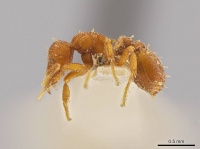Octostruma lutzi
| Octostruma lutzi | |
|---|---|

| |
| Scientific classification | |
| Kingdom: | Animalia |
| Phylum: | Arthropoda |
| Class: | Insecta |
| Order: | Hymenoptera |
| Family: | Formicidae |
| Subfamily: | Myrmicinae |
| Tribe: | Attini |
| Genus: | Octostruma |
| Species: | O. lutzi |
| Binomial name | |
| Octostruma lutzi (Wheeler, W.M., 1913) | |
Octostruma lutzi is an island species endemic to Dominica and Guadeloupe in the Lesser Antilles. The syntypes were collected "sifting leaves in forest and among bananas and tree-ferns along the edge of it." (Wheeler, 1913). On Guadeloupe, it occurs from sea level to 800 m elevation, in a variety of forested habitats including wet and seasonal dry forest, mahogany plantation, and cloud forest. All Guadeloupe specimens are from Winkler samples of sifted litter and rotten wood from the forest floor. Dealate queens often occur together with workers in litter samples. (Longino 2013)
Identification
Keys including this Species
Distribution
Distribution based on Regional Taxon Lists
Neotropical Region: Dominica (type locality), Guadeloupe, Montserrat.
Distribution based on AntMaps
Distribution based on AntWeb specimens
Check data from AntWeb
Countries Occupied
| Number of countries occupied by this species based on AntWiki Regional Taxon Lists. In general, fewer countries occupied indicates a narrower range, while more countries indicates a more widespread species. |

|
Estimated Abundance
| Relative abundance based on number of AntMaps records per species (this species within the purple bar). Fewer records (to the left) indicates a less abundant/encountered species while more records (to the right) indicates more abundant/encountered species. |

|
Biology
|
Castes
Nomenclature
The following information is derived from Barry Bolton's Online Catalogue of the Ants of the World.
- lutzi. Rhopalothrix (Octostruma) lutzi Wheeler, W.M. 1913d: 241 (w.q.) DOMINICA. Combination in Octostruma: Brown, 1949f: 92. Junior synonym of balzani: Brown & Kempf, 1960: 194. Revived from synonymy: Longino, 2013: 41.
Unless otherwise noted the text for the remainder of this section is reported from the publication that includes the original description.
Longino (2013) - The original syntype series of O. lutzi contained both O. lutzi (one of which was designated lectotype in Brown and Kempf, 1960) and Eurhopalothrix guadeloupensis. Wheeler's description of O. lutzi pertains to O. lutzi for the most part, but the description of pilosity better fits the Eurhopalothrix worker. The identity of the described queen remains uncertain.
The degree to which the Dominica and Guadeloupe populations are differentiated is poorly known. Examined workers from Dominica (the MCZ type series of O. lutzi) have distinctly narrower heads than workers from Guadeloupe (CI 102–104 vs. 107–109). The Dominica workers are light orange brown and the Guadeloupe workers are dark brown, but the former are also over 100 years old and may have faded.
Description
Worker
Longino (2013) - Dominica: HW 0.56–0.61, HL 0.55–0.59, WL 0.61–0.64, CI 102–104 (n=3). Guadeloupe: HW 0.57–0.62, HL 0.53–0.58, WL 0.60–0.65, CI 107–109 (n=6). Mesosoma typically with two pairs spatulate setae, one on pronotum and one on mesonotum (pronotal setae lacking in all other balzani-group species except Octostruma batesi and Octostruma betschi); posterolateral margin of head subequal to or longer than anterolateral margin (posterolateral margin shorter than anterolateral margin in O. batesi and O. betschi); color dark brown on Guadeloupe.
Queen
Longino (2013) - The Dominica queen described by Wheeler was not examined. Guadeloupe queen: HW 0.65–0.66, HL 0.61–0.62, WL 0.77–0.80, CI 105–108 (n=3). Labrum, mandible, scape, antennal scrobe, and head sculpture similar to worker; face with 8–10 erect setae distributed symmetrically around lateral and posterior margins of head, a seta on low ridge in front of each compound eye, 4 setae across vertex between compound eyes; ocelli distinct; compound eye large, multifaceted, about 12 ommatidia in longest row.
Mesosoma with queen-typical alar sclerites; sculpture like workers; anepisternum and katepisternum separated by strong sulcus; posterodorsal propodeum concave; propodeal spines pronounced, in the form of flattened perpendicular plates, acute in profile; pronotum with 4 erect setae, mesoscutum with 10–12, axilla with 1, scutellum with 2, metanotum with 2, petiolar node with 4, postpetiolar disc with 4, first gastral tergite with about 40. Other characters similar to worker.
Type Material
Lectotype worker: Dominica, Laudet & Long Ditton, near Roseau (Lutz) Museum of Comparative Zoology, MCZ-ENT00303378 (examined); non-type queen: same data as lectotype AMNH? (not examined).
References
- Longino, J.T. 2013. A revision of the ant genus Octostruma Forel 1912 (Hymenoptera, Formicidae). Zootaxa 3699, 1-61. doi:10.11646/zootaxa.3699.1.1
- Meurgey, F. 2020. Challenging the Wallacean shortfall: A total assessment of insect diversity on Guadeloupe (French West Indies), a checklist and bibliography. Insecta Mundi 786: 1–183.
References based on Global Ant Biodiversity Informatics
- Galkowski C. 2016. New data on the ants from the Guadeloupe (Hymenoptera, Formicidae). Bull. Soc. Linn. Bordeaux 151, 44(1): 25-36.
- Longino J. T. 2013. A revision of the ant genus Octostruma Forel 1912 (Hymenoptera, Formicidae). Zootaxa 3699(1): 1-61.
- Perrault G. H. 1988. Octostrumma [sic] betschi, n. sp. de Guyane Française (Hymenoptera, Formicidae). Revue Française d'Entomologie (Nouvelle Série) 10: 303-307.


